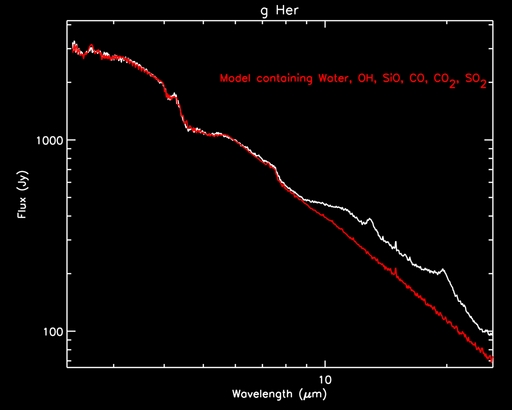Molecular Spectroscopy

The delicate blue tail observed in many comets is composed of ionized molecules, of which carbon monoxide particularly glows blue when reacquiring electrons. Image of comet Hale-Bopp by John Gleason.
Molecules are found in every corner of the universe : from star-forming regions over comets to entire galaxies. To date, well over 140 different molecules have been detected in space - from common and well-known substances such as water to more complex molecules such as alcohol. The detection of all these molecules offers astronomers a great deal of insight into the chemistry occurring in these environments. But molecules are much more powerful than that. Astronomers can use molecules for instance as distant thermometers and measure temperatures all across the universe. This is accomplished by molecular spectroscopy. For a brief introduction to molecular spectroscopy with some examples, click here.
In my research, I study molecules around evolved stars, star-forming regions, the Interstellar Medium (ISM) and even in entire galaxies. Such research projects generally involve a comparison between spectroscopic observations of these objects and model spectra for specific molecules at different temperatures and densities (see below for an example). I have calculated such model spectra for many different molecules, and simulated observations with various ground-based instruments as well as with satellite data. These models can be directly compared to astronomical observations to determine temperatures and column densities. My good friend and tech-savvy astro-collaborator Andrew Markwick (from the Astrophysics group at the University of Manchester) built a nice website around this database of molecular model spectra :
Although the database contains many model spectra, it is far from being complete : of the more than 140 molecules have been detected in space, high-quality data needed for calculating the model spectra is only available for a handful of molecules. Future additions to the database will therefore include bands of those molecules which are detected in space and for which the molecular parameters are known but for which line lists are not available yet.
Molecules and molecular spectroscopy will play a particularly important role in some current and future key observatories. The Herschel Space Observatory was succesfully launched in 2009 and is designed to study many astrophysical aspects through the use of molecular spectrosocpy. Canada is highly involved in this satellite through contributions to two of the three instruments on board Herschel: the SPIRE instrument and HIFI. And, of course, the success of the PACS instrument is the result of hard work by -- amongst others -- my friends and collaborators from Leuven, Belgium. Similarly, the Atacama Large Millimeter/submillimeter Array (ALMA) is currently being constructed in the Chilean Atacama desert. This is one of the largest ground-based astronomy projects in the next decade, and will similarly be geared toward studying the molecular universe. Canada is strongly involved in this project by providing the receivers (see also this page).

An example of molecular spectroscopy in the infrared. The white graph is the infrared spectrum of an evolved star called g Her, observed with the Short Wavelength Spectrometer (SWS) on boad the Infrared Space Observatory (ISO). The red curve is a model spectrum I calculated which contains 6 different molecules, with temperatures between 500K and 2000K. Note that at longer wavelengths, the two curves do not match because of the presence of oxide dust in this object.



